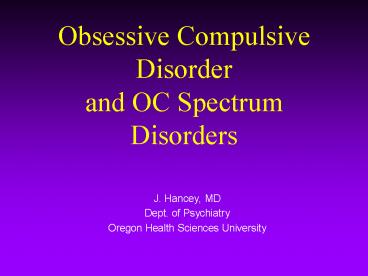Obsessive Compulsive Disorder and OC Spectrum Disorders - PowerPoint PPT Presentation
1 / 33
Title:
Obsessive Compulsive Disorder and OC Spectrum Disorders
Description:
Title: No Slide Title Author: MIRECC Last modified by: James Hancey Created Date: 1/10/2000 3:34:49 PM Document presentation format: On-screen Show (4:3) – PowerPoint PPT presentation
Number of Views:166
Avg rating:3.0/5.0
Title: Obsessive Compulsive Disorder and OC Spectrum Disorders
1
Obsessive Compulsive Disorder and OC Spectrum
Disorders
- J. Hancey, MD
- Dept. of Psychiatry
- Oregon Health Sciences University
2
The many faces of OCD
- Dermatologist Chapped hands, eczema,
Trichotillomania - Oncologist/Infectious disease Hypochondriasis
(Cancer, AIDS) - Neurologist OCD associated with Tourettes or
other neurologic disorders - Obstetrician OCD during pregnancy or postpartum
- Pediatrician Compulsive behavior, OCD secondary
to Sydenhams chorea, difficulty in school - Plastic surgeon Body dysmorphic disorder
- Dentist Gum lesions from excessive teeth
bleeding - Family practitioner Report of family member
washing or checking excessively, comorbid
affective or anxiety disorders, all of the above.
3
Definitions of OCD
- An anxiety disorder characterized by
- Obsessions
- Recurrent and persistent ideas, impulses,
thoughts, images that are intrusive and sometimes
senseless - Compulsions
- Repetitive, seemingly purposeful behaviors
performed in response to an obsession (e.g.,
ritualistic or stereotypic behavior) - Anxiety arises around resistance to obsessions
and/or compulsions - Anxiety may or may not be the primary feature
of OCD
4
Diagnostic Criteria for OCD
- Either obsessions or compulsions
- Recognized by patients as excessive or
unreasonable - Obsessions or compulsions cause marked distress,
are time consuming, or significantly interfere
with functioning - DSM-IVtm 1994417-423
5
Obsessive-Compulsive Spectrum Disorders
Preoccupations with bodily sensations or
appearance
Body Dysmorphic Disorder Depersonalization
Anorexia nervosa Hypochondriasis
OCD
Tourettes syndrome Sydenhams chorea Torticollis
Autism ADHD
Sexual compulsions Trichotillomania Pathological
gambling Kleptomania
Self-injurious behavior
Neurologic disorders
Impulsive disorders
Hollander et al, J Clin Psychiatry, 1966
6
Epidemiology of OCD
- 6-month point prevalence 1.6
- Life-time prevalence 2.5
- An estimated 3.9 million Americans had OCD in
1990 - 4th most common psychiatric disorder
- Double that of panic disorder or schizophrenia
7
(No Transcript)
8
(No Transcript)
9
Biological Differences of OCD
- Anatomy
- decreased caudate nucleus volume
- Biochemistry
- increased CSF 5-HIAA
- Physiology
- increased frontal and pre-orbital glucose
utilization
10
Precipitating Factors
- 25--depression and/or anxiety accompanied the
initial symptoms - 50 - 60--stressors around the time of onset of
symptoms - --pregnancy
- --childbirth
- --sexual problems
- --death in family
- Streptococcal pharyngitis
11
The Streptococcal Connection
- Increasing evidence for an autoimmune etiology
- Group A beta hemolytic streptococcus
- Antineuronal antibodies
- Genetic vulnerability
- D8/17 positivity as a marker
12
PANDAS
- Pediatric
- Autoimmune
- Neuropsychiatric
- Disorders
- Associated with
- Streptococcal infections
13
Treatment
- Medications
- Cognitive Behavioral Therapy
14
COGNITIVE THERAPY
15
Cognitive Therapy
- Re-label
- Re-attribute
- Re-focus
- Re-evaluate
Schwartz, J. Brain Lock
Pearl Use a mental garbage can.
16
BEHAVIORTHERAPY
17
(No Transcript)
18
Behavior Therapy
- Effective behavior therapy involves
- Exposure facing feared or avoided object,
thought, situation, or place, preferably in vivo - Response or ritual prevention delaying and
diminishing anxiety-reducing compulsions
19
SUDS List (Subjective Units of Distress)
- List compulsive behaviors
- Assign SUDs value to each (0-100)
- Rank order from top to bottom
- Begin at the bottom of the list
- Best source Baer, Lee. Getting Control.
Pearl Break up complex rituals into various
parts
20
Serotonin Reuptake Inhibitors in the Treatment
ofObsessive Compulsive Disorder
21
(No Transcript)
22
Fluoxetine vs Clomipramine
- 20 week crossover
- No difference between YBOCS
- Delayed response to 2nd drug
- Relapse occurred during washout
- ltADR with fluoxetine
- ADR adverse drug reaction
- Pigott et al. Arch Gen Psychiatry,
199047926-932.
23
(No Transcript)
24
(No Transcript)
25
(No Transcript)
26
Factors Affecting Serum Drug Levels
- Absorption
- Protein binding
- Metabolism
- Elimination
27
Utilizing P450 Inhibition
- 1A2
2D6
CMI
Desmethyl CMI
inactive
28
The Role of AnxiolyticsWhen, What, and When to
Worry
- Initial stages of treatment, prn
- BZDs - the long and short of it
- abuse, dependence and addiction
29
Benzodiazepine Issues
- Abuse
- Physical dependence
- Addiction
30
Treatment Strategies
- SSRI beginning at low doses, gradually increasing
to maximum doses - minimum 10 week trial
- switch SSRIs
- augmentation
- clonazepam
- atypicals
- opioid agonism/antagonism
- acamprosate
- cognitive-behavioral therapy
- surgery
31
(No Transcript)
32
Gamma Knife
33
(No Transcript)































